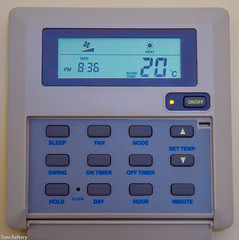One of the reasons I started working with GreenMonk back in 2008 was that James heard my Electricity 2.0 vision, and totally bought into it.
The idea, if you’re not familiar with it, was that as smart grids are deployed, homes will become more connected, devices more intelligent, and home area networks would emerge. This would allow the smart devices in the home (think water heaters, clothes dryers, dish washers, fridges, electric car chargers, etc.) to listen to realtime electricity prices, understand them, and adjust their behaviour accordingly. Why would they want to do this? To match electricity demand to its supply, thereby minimising the cost to their owner, while facilitating the safe incorporation of more variable suppliers onto the grid (think renewables like solar and wind).
That was 2008/2009. Fast forward to the end of 2013 and we see that smart meters are being deployed in anger, devices are becoming more intelligent and home area networks are becoming a reality. The Internet of Things, is now a thing (witness the success of devices like Nest’s Thermostat and Protect, the Philips Hue, and Belkin’s WeMo devices). Also, companies like Gridpoint, Comverge and EnerNoc are making demand response (the automatic reduction of electricity use) more widespread.
We’re still nowhere near having realised the vision of utility companies broadcasting pricing in realtime, home appliances listening in and adjusting behaviour accordingly, but we are quite a bit further down that road.
One company who have a large part to play in filling in some of the gaps is GE. GE supplies much of the software and hardware used by utilities in their generation, transmission and distribution of electricity. This will need to be updated to allow the realtime transmission of electricity prices. But also, GE is a major manufacturer of white goods – the dish washers, fridges, clothes dryers, etc. which will need to be smart enough to listen out for pricing signals from utilities. These machines will need to be simple to operate but smart enough to adjust their operation without too much user intervention – like the Nest Thermostat. And sure enough, to that end, GE have created their Connected Appliances division, so they too are thinking along these lines.
More indications that we are headed the right direction are signalled by energy management company Schneider Electric‘s recently announced licensing agreement with ioBridge, and Internet of Things connectivity company.
Other big players such as Intel, IBM and Cisco have announced big plans in the Internet of Things space.
The example in the video above of me connecting my Christmas tree lights was a trivial one, obviously. But it was deliberately so. Back in 2008 when I was first mooting the Electricity 2.0 vision, connecting Christmas tree lights to the Internet and control them from a phone wouldn’t have been possible. Now it is a thing of nothing. With all the above companies working on the Internet of Things in earnest, we are rapidly approaching Electricity 2.0 finally.
Full disclosure – Belkin sent me a WeMo Switch + Motion to try out.

